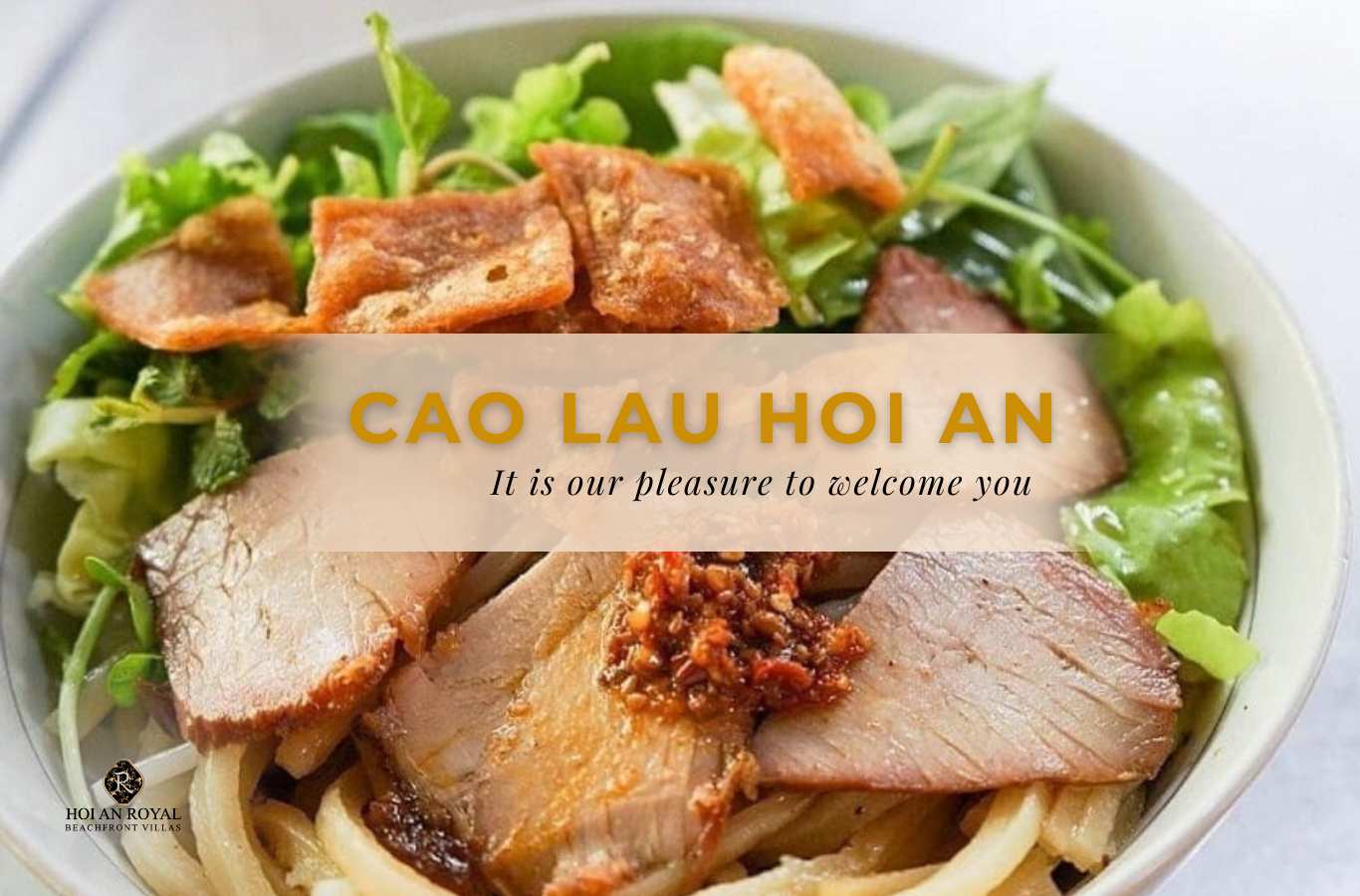Aromatic with the scent of firewood, chewy and crispy noodles, rich char siu pork – these are the usual descriptions of Cao Lau Hoi An. But to truly understand and appreciate this dish, you need more than that. The article below by Hoi An Royal Beachfront Villas will introduce the origins, interesting facts about the dish, and the proper way to enjoy it so you can fully experience the flavor and culture of the ancient town.
Table of Contents
ToggleCao Lau Hoi An – The Origin and Special Meaning Behind the Name “Cao Lau”
Cao Lau is the culinary essence of Hoi An, distinguished by its golden, chewy and crispy noodles, carrying a hint of smokiness thanks to rice soaked in ash water made from tram firewood from Cu Lao Cham and cooked using water from Ba Le well. This dish is often served with char siu pork, crispy pork skin, shrimp, fresh herbs, roasted peanuts, and sesame rice crackers, all harmoniously blended to create a lingering impression on anyone who tastes it.
The unique feature of Cao Lau lies in its concentrated xiu sauce, made from pork bones and prepared with a secret recipe. Only a small amount is used for mixing, just enough to enhance the flavor without overpowering the taste of the noodles.
Legend has it that Cao Lau appeared in the 17th century, when Hoi An was a bustling trading port welcoming many Japanese and Chinese merchants. One theory suggests the dish was inspired by Ise Udon – a soft Japanese noodle dish served with soy sauce, which shares a similar preparation and presentation.
Another theory proposes that the name “Cao Lau” originates from the Chinese words “Gao Lou,” meaning “high floor.” In the past, eateries in Hoi An often had upper floors reserved for wealthy merchants, and this dish was served on those high floors, where diners could enjoy the food while watching the crowd move through the old town, evoking a sense of elegance and refinement.
Cao Lau is not just a dish – it’s an experience. The name conjures images of leisurely diners enjoying a special bowl of noodles on an upper floor, gazing out over the moss-covered old town, letting both taste and soul immerse in the beauty of Hoi An’s culture, history, and cuisine.
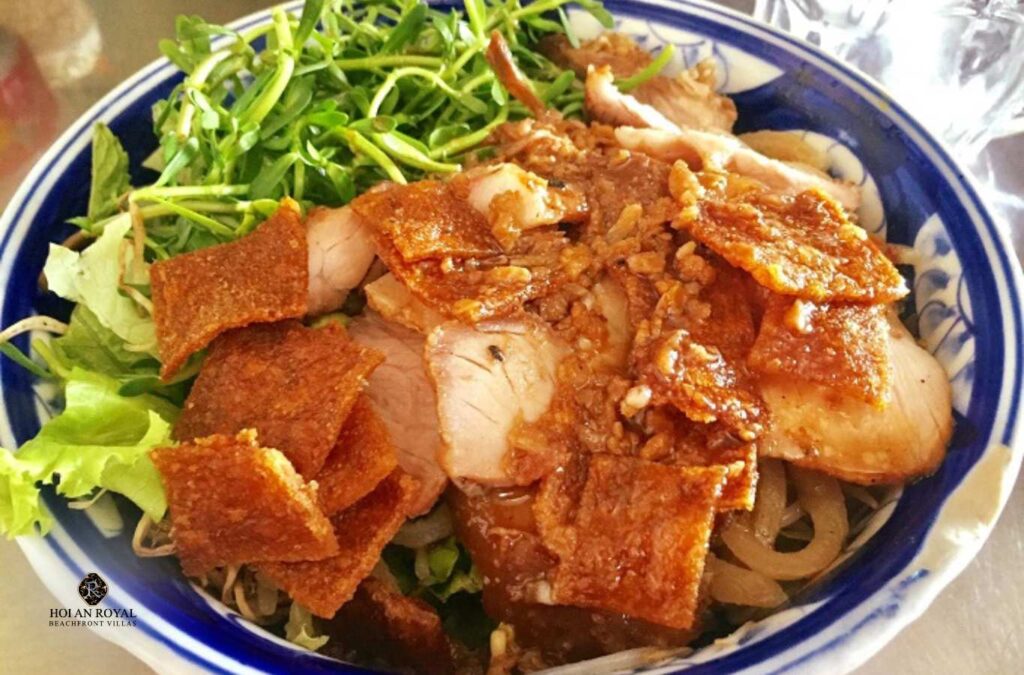
How is Cao Lau different from Mi Quang, Pho, or Bun?
Let’s explore the differences between Cao Lau – a signature dish of Hoi An – and other popular Vietnamese dishes like Mi Quang, Pho, or Bun through the comparison table below:
| Criteria | Cao Lau | Mi Quang | Pho | Bun |
| Noodle type | Thick, golden, chewy and crispy noodles made from rice soaked in tram ash water and Ba Le well water, steamed multiple times | Noodles made from simple rice flour, thinner and softer | Made from rice flour, thin, soft, moderately chewy | Made from rice flour, small, soft, and round |
| Broth | Thick, rich, and minimal; stewed from pork bones, features signature xiu sauce | Clear, aromatic broth from slow-cooked pork or chicken bones | Clear, aromatic broth from stewed beef bones | Clear, light broth made from pork or beef bones |
| Accompaniments | Char siu (roast pork), crispy pork skin, shrimp, fresh herbs, crispy sesame rice crackers | Pork, chicken, shrimp, quail eggs, fresh herbs, grilled rice crackers | Rare or cooked beef, herbs, scallions | Beef, chicken, pork rolls, fresh herbs |
| Eating style | Mixed with xiu sauce, served with fresh herbs, topped with crispy rice crackers | Served with broth, fresh herbs, and grilled rice crackers | Served with hot broth and herbs | Served with broth and fresh herbs |
| Distinct features | Unique chewy-crispy noodles, rich concentrated broth, crispy sesame crackers add texture | Light broth, soft noodles, diverse toppings | Fragrant, light broth, soft noodles | Soft noodles, light broth, often eaten for breakfast |
Lesser-known facts about Cao Lau
Cao Lau is not just a specialty dish—it carries many fascinating stories behind it. Here are a few things you may have never heard before:
- Ba Le well water – the “secret” behind authentic Cao Lau noodles: People in Hoi An traditionally believe that to make true Cao Lau noodles, Ba Le well water is essential. This water has a mild alkalinity, which gives the noodles their signature chewy, crispy texture and golden color. Additionally, the rice used for the noodles is soaked in ash water made from tram trees on Cu Lao Cham island, creating a flavor that is distinct and impossible to replicate elsewhere.
- Cao Lau was once a dish for Hoi An’s elite: Though now a common street food, Cao Lau once held special meaning in Hoi An’s culinary culture. The name “Cao Lau” originates from the image of wealthy merchants being served on high floors—spaces adorned with lanterns and offering private dining. The dish was once regarded as a symbol of luxury and social status.
- A specialty dish that has gained global recognition: International media and food bloggers such as CNN, BBC, and The Guardian have featured Cao Lau as a “must-try specialty when visiting Vietnam.” Thanks to its unique flavor and cultural story, the dish has helped bring Hoi An cuisine—and more broadly, Vietnamese cuisine—closer to the global community.
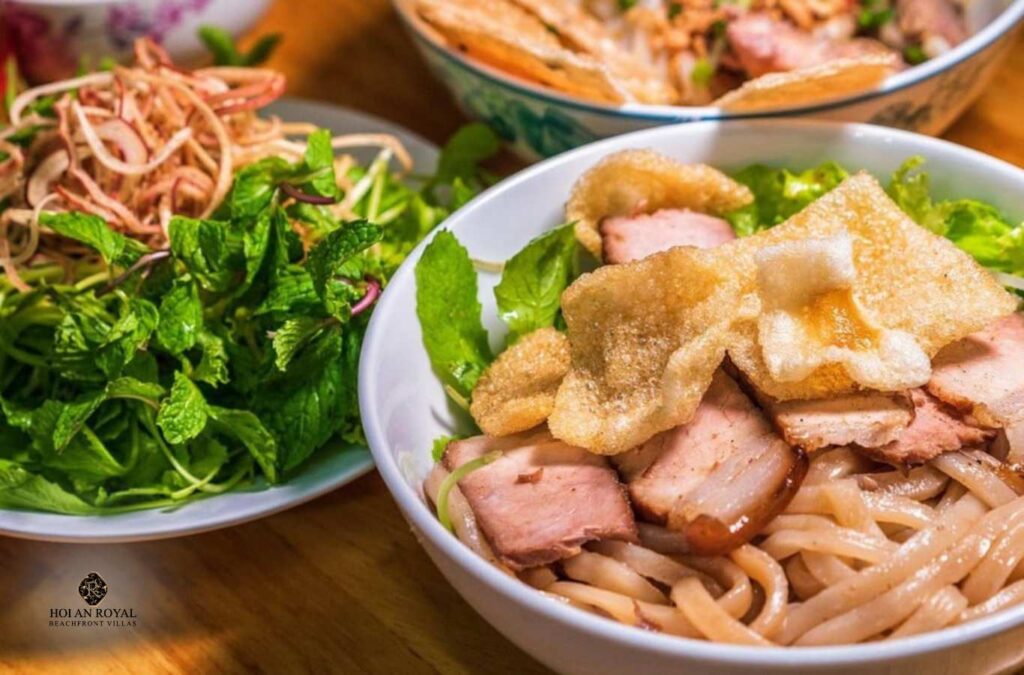
Where to eat authentic Cao Lau in Hoi An?
Cao Lau Ba Le
- Opening hours: 11:00 – 21:00
Cao Lau Ba Le has long been a favorite spot for food connoisseurs. The restaurant is renowned for using premium rice soaked in tram ash water, combined with pure water from Ba Le well—two key elements that create the golden, chewy noodles with a signature smoky flavor.
The dish here is rich and authentically Quang-style, leaving diners longing to return just to relive the true “Hoi An” essence in every strand of noodle.
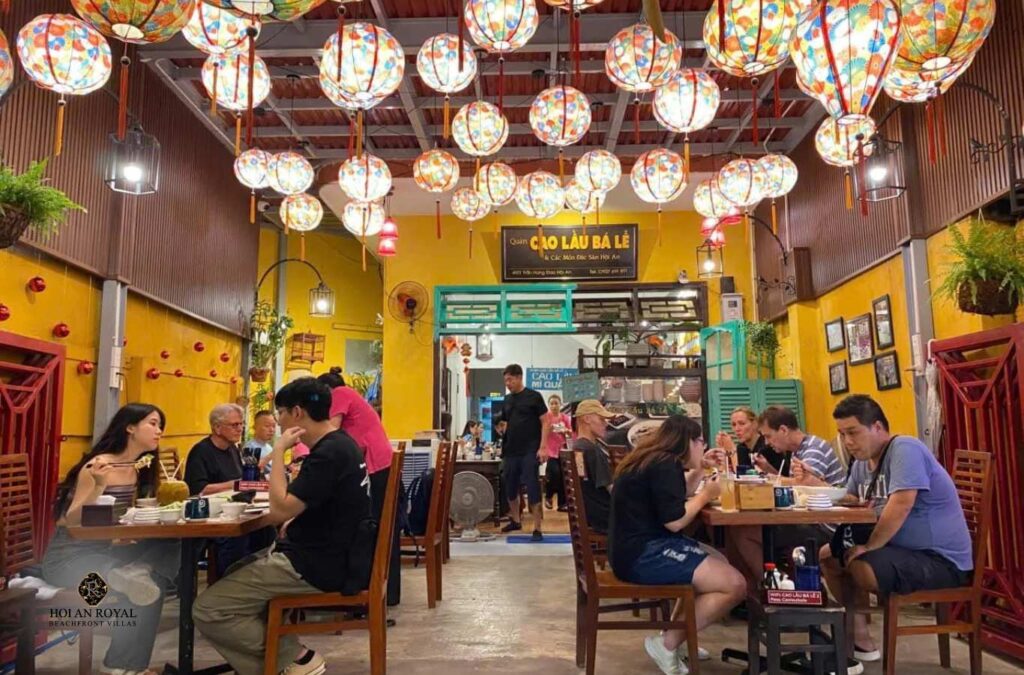
Cao Lau Co Lien
- Opening hours: 06:30 – 19:30
- Price: 20,000 – 30,000 VND
With over 30 years of history, Co Lien’s eatery has become a nostalgic landmark for generations in Hoi An. Her cao lau preserves the traditional taste with chewy noodles, flavorful char siu pork, crisp fresh herbs, and a rich yet light xiu sauce.
The space is rustic and welcoming, with fast and thoughtful service. It’s always bustling with locals and tourists alike, all searching for that old-time flavor in the moss-covered heart of the city.
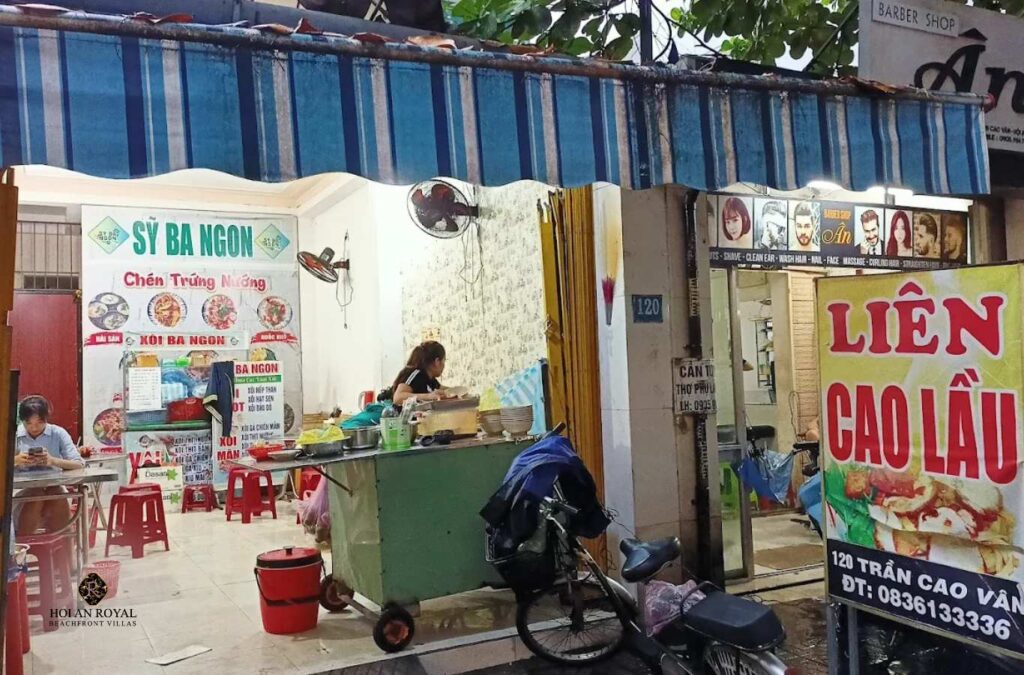
Cao Lau Ba Be
- Opening hours: 14:30 – 22:00
- Price: 20,000 – 45,000 VND
If you’re looking for a high-quality, reasonably priced bowl of cao lau in the center of the Old Town, Ba Be is a perfect choice. The generous portion includes golden chewy noodles, aromatic fatty xiu sauce, and thick-cut, tender char siu pork.
Though the space is small and simple, it’s always filled with laughter and conversation from visitors enjoying a delicious break while strolling Tran Phu Street.
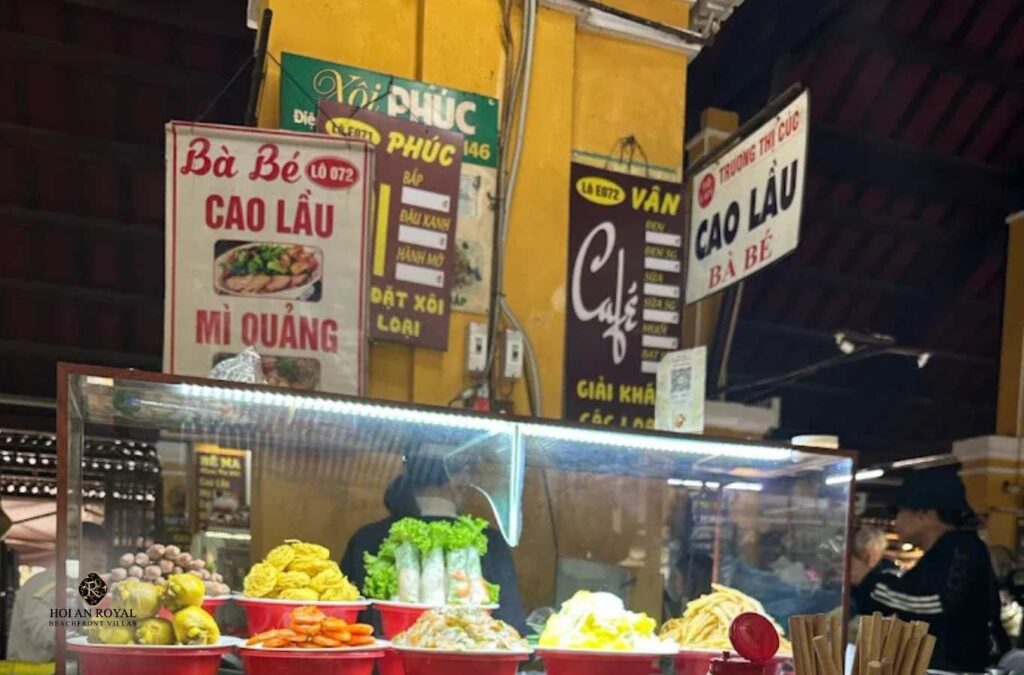
Cao Lau Thanh
- Opening hours: 07:00 – 19:00
- Price: 15,000 – 30,000 VND
Tucked away in a small alley, Cao Lau Thanh wins hearts with its clean, casual setting and friendly service. The dish isn’t flashy in appearance, but it captures the rustic, sincere spirit of the Quang people.
The noodles are perfectly chewy and crispy, the xiu sauce mildly fragrant, the pork tender and sweet, all blended with fresh herbs to create an unforgettable flavor.
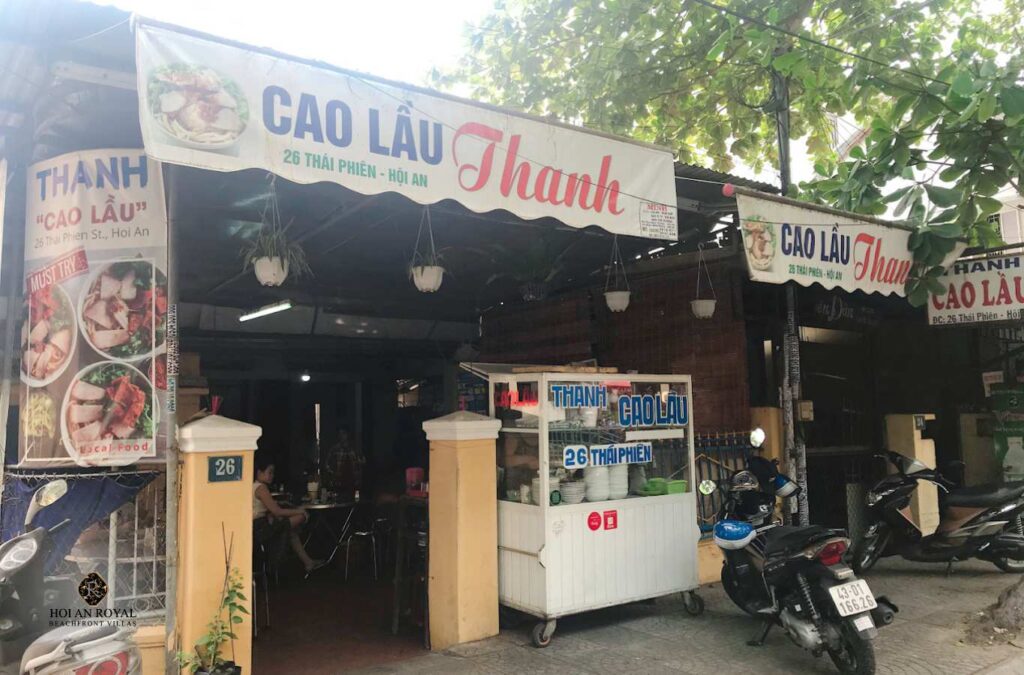
Cao Lau Khong Gian Xanh
- Opening hours: 09:30 – 21:00
- Price: 20,000 – 40,000 VND
Khong Gian Xanh is a popular choice among tourists thanks to its spacious, airy setting that reflects both traditional Hoi An charm and a touch of modernity.
The menu offers a variety of cao lau portions—from light servings to large, hearty bowls. The noodles are chewy and crispy, the xiu sauce rich, and the char siu pork tender, all coming together in perfect harmony. With reasonable prices and fast service, it’s a great choice for lunch or dinner after exploring the town.
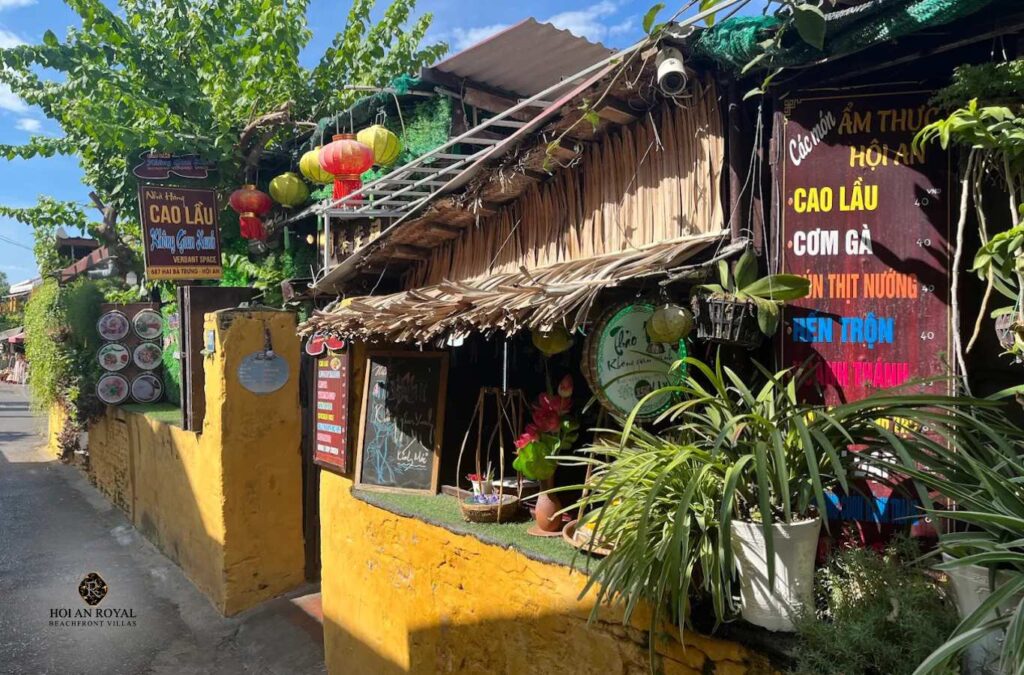
Tips for enjoying authentic Cao Lau like a local in Hoi An
To eat Cao Lau Hoi An like a true local, you should keep in mind the following important tips:
- Choose a reputable eatery in Hoi An: Locals often frequent long-standing traditional Cao Lau restaurants, where the noodles are handmade properly, the char siu pork is richly marinated, the xiu sauce is well-balanced, and the herbs are fresh and crisp. Popular spots highly rated by both locals and visitors include Ong Hai, Ba Be, or various eateries within the Old Town of Hoi An.
- Follow the correct eating order:
- When a bowl of Cao Lau is served, you’ll notice blanched bean sprouts at the bottom, topped with golden noodles, thinly sliced char siu pork, aromatic herbs (cai con, hung lui, lettuce), and crispy sesame rice crackers.
- Locals typically pour about 2–3 tablespoons of rich xiu sauce over the noodles to let them soak in the flavor, avoiding too much liquid to prevent the noodles from becoming soggy.
- Before eating, you may squeeze in some fresh lime and add a bit of Hoi An chili sauce or green bird’s eye chili to enhance the spicy and aromatic kick.
- Eat with herbs and sesame crackers: Fresh herbs help balance the richness of the meat and the chewiness of the noodles, while the crispy sesame crackers provide a delightful texture contrast that elevates the entire dish.
- Avoid adding too much broth: Unlike pho or mi Quang, Cao Lau uses very little broth—just enough to enhance the noodles without compromising their signature chewy-crispy texture. Adding too much broth will diminish the uniqueness of the dish.
You don’t have to be from Hoi An to enjoy Cao Lau Hoi An like a local. Just follow the simple tips shared by Hoi An Royal Beachfront Villas above. Try it in the authentic Hoi An style at least once, and you will feel the difference – not only in the taste, but also in the way this dish tells you the story of a peaceful countryside.
